Oscilllator
National Hazard
   
Posts: 659
Registered: 8-10-2012
Location: The aqueous layer
Member Is Offline
Mood: No Mood
|
|
problems with synthesis of propylene carbonate
I decided to open a separate thread on this topic because the previous thread had degenerated onto arguments on electrochemistry and also because as far as I can tell I am the first one to actually conduct
the experiment.
The experiment was based one the patent elementcollector1 posted in the previous thread. I have attached the patent here aswell. The reaction
essentially goes:
Propylene glycol + Urea -> Propylene carbonate + 2NH3
and the patent recomments a 1.5:1 molar ratio of PG to urea, using a zinc oxide catalyst.
Attachment: propylene carbonate.pdf (346kB)
This file has been downloaded 1692 times
I have attempted to conduct the experiment 4 times previously, but only the most recent method shows any promise, as all of the previous attempts
failed for one reason or another.
The most recent attempt was conducted as follows:
74g Urea (from fertiliser), 114g propylene glycol (food grade) and 2g zinc oxide were mixed in a 1L round-bottomed flask (RBF). The one-litre rbf
flask was necessary because the reaction bubbles extremely vigorously, and so unless a large flask is used the condenser is almost immediately
overwhelmed.
This mixture was then refluxed for 2 hours under the vacuum from an aspirator, using a sand bath.
This mixture was then distilled at atmospheric pressure. There were no distinct fractions, the temperature a the still head rose smoothly from 180 to
240 degrees. The boiling point of propylene glycol is 188 and the b.p. of propylene carbonate is 242. The fraction boiling above 210 was collected,
and was found to have a density of 1.16g/cm3. The density of propylene glycol is 1g/cm3 and propylene carbonate is
1.2g/cm3. This indicates that the distillate contained a decent amount of propylene carbonate.
During the distillation copious quantities of ammonia were still evolving which indicated 2 hours is not nearly long enough for the reaction to
proceed to completion.
One strange observation was that during the distillation a white crystalline substance sublimed into the condenser (see picture). This was dissolved
in a small amount of water and interestingly 2 layers appeared. Can anybody explain this?
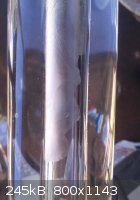
Another observation was that a brittle caramel-coloured foam formed in the distilling flask upon cooling, indicating that some of the propylene
carbonate polymerised. Perhaps vacuum distillation could prevent this in future?
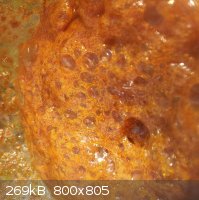
One problem is how to separate the propylene glycol from the carbonate. Distillation seems the best option, but as mentioned there are no distinct
temperatures at the still head. Ideas?
Also, the patent says the optimal reaction temperature is 170 AND the reaction should be carried out under vacuum. I don't see how its possible to
carry this reaction under a decent vacuum if the bp of propylene glycol is 188.
I will post the results of any additional experiments I conduct. If somebody could let me know how to post full-sized images I would greatly
appreciate it.
|
|
|
UnintentionalChaos
International Hazard
    
Posts: 1454
Registered: 9-12-2006
Location: Mars
Member Is Offline
Mood: Nucleophilic
|
|
Nice work. I've seen this type of reaction come up in a paper or two and the ability to make carbonate esters without phosgene is quite cool and the
method accessible to the amateur.
For separation of the product and reactant, I suggest vacuum fractionation, though that may be beyond your capabilities. 54 degrees C between boiling
points should be a fairly easy fractionation. The temperature gap between ethylene glycol and ethylene carbonate is a little wider as well, which may
make that a better approach (unless you want propylene carbonate, of course).
The crud in the flask may be a mix of short chain poly-propylene carbonate, larger cycles, or urea condensation products such as biuret, cyanuric
acid, ammelide, ammeline, melamine, and polymers of the above.
The crystalline solid is probably ammonium carbonate/bicarbonate resulting from trace water hydrolyzing urea.
[Edited on 11-24-13 by UnintentionalChaos]
Department of Redundancy Department - Now with paperwork!
'In organic synthesis, we call decomposition products "crap", however this is not a IUPAC approved nomenclature.' -Nicodem
|
|
|
Oscilllator
National Hazard
   
Posts: 659
Registered: 8-10-2012
Location: The aqueous layer
Member Is Offline
Mood: No Mood
|
|
Vacuum fractionation sounds like a good idea. Its well within my capabilities, as I recently purchased a whole bunch of glassware from laboy  . Ill try that along with the longer reaction time next time I attempt the reaction. . Ill try that along with the longer reaction time next time I attempt the reaction.
|
|
|
UnintentionalChaos
International Hazard
    
Posts: 1454
Registered: 9-12-2006
Location: Mars
Member Is Offline
Mood: Nucleophilic
|
|
I'm not sure if I'm reading the original literature properly, but it sounds like the use of vacuum is only to remove ammonia as it is formed. I'd
imagine that it is not maintained constantly but done periodically. Alternately, it seems like a flow of inert gas through the reaction vessel would
also work.
Can I inquire as to the weight of your distillation fractions?
Department of Redundancy Department - Now with paperwork!
'In organic synthesis, we call decomposition products "crap", however this is not a IUPAC approved nomenclature.' -Nicodem
|
|
|
Oscilllator
National Hazard
   
Posts: 659
Registered: 8-10-2012
Location: The aqueous layer
Member Is Offline
Mood: No Mood
|
|
I didn't weigh the individual fractions, however I estimate the final fraction to be around 100ml. I think the vacuum has to be applied constantly,
because if the vacuum is not applied then the strange crystalline substance begins to appear in the reflux condensor. Is it possible that the
crystalline substance is sublimed urea?
|
|
|
deltaH
Dangerous source of unreferenced speculation
    
Posts: 1663
Registered: 30-9-2013
Location: South Africa
Member Is Offline
Mood: Heavily protonated
|
|
The white crystalline substance may be ammonium carbamate which reversibly decomposes under heating or vacuum, it appears volatile because of the
reversible reaction:
2NH3(g) + CO2(g) <=> NH4COONH2(s) + heat
Have a look at the attached leaflet from BASF about it.
Attachment: ammonium carbamate.pdf (49kB)
This file has been downloaded 4911 times
[Edited on 26-11-2013 by deltaH]
|
|
|
Oscilllator
National Hazard
   
Posts: 659
Registered: 8-10-2012
Location: The aqueous layer
Member Is Offline
Mood: No Mood
|
|
I suppose it could be possible that it was ammonium carbonate if some of the urea hydrolysed to CO2 and NH3, then condensed to ammonium carbamate.
However I find the idea plausible but unlikely, primarily because the hydrolysis of urea is quite slow even in strongly basic conditions.
I did save a solution of this substance, so tomorrow I'll go and heat it up, observe the results, then report back.
|
|
|
UnintentionalChaos
International Hazard
    
Posts: 1454
Registered: 9-12-2006
Location: Mars
Member Is Offline
Mood: Nucleophilic
|
|
Okay, I have some info for this thread that could also go in the "failed prep" thread.
I ran an analogous reaction with 0.75mol ethylene glycol and 0.5mol of urea, but did not run under vacuum.
I prepared fresh ZnO by dissolving 6.54g (10mmol) of the metal in 25ml (~250mmol) of 31.45% HCl and ~50ml water. After dissolution, I added 11.00g
(275mmol) of NaOH in 100ml of water to the zinc solution, causing a gelatinous precipitate. I diluted the mixture to 200ml with distilled water and
brought it to a boil, which broke down the precipitate into a fine powder. The solid was washed by decanting with five 100ml portions of boiling water
(decanting to 100ml each time), vac filtered, and rinsed with acetone to speed drying. The solid was heated at 200C for an hour to convert zinc
hydroxide into zinc oxide. A yield of 8.08g (99% from zinc) was obtained as a fine white powder. Visually, mechanical loss was nearly nonexistent and
Zn(OH)2 is highly insoluble (except with excess base present) so I have no reason to doubt the yield.
A 500ml RBF was charged with 30.03g (500mmol) of recrystallized urea (in retrospect this is years old and probably has some water content), 46.56g
(750mmol) of ethylene glycol distilled from antifreeze (should have no appreciable water content. It was a middle fraction with a stable b.p. on a
fractionating column). Finally, a stirbar and 0.60g of the previously prepared zinc oxide was added. The reaction was set up in an oil bath with a
thermometer and a Friedrich condenser was attached which has considerable space inside to deal with the "mystery solid."
The exit of the condenser was connected to an inverted funnel above a stirred beaker of water to scrub ammonia. At roughly 135C (urea's melting point)
the solution became clear. Completely. The zinc oxide had dissolved, likely as an alkoxide. At around 145C, the first traces of ammonia were noted in
the scrubber. A condensate collected in the top of the flask and neck of the Friedrich condenser. This is presumed to be concentrated ammonia solution
resulting from water present. The rate of bubbling, which was not violent was noted to increase as the temperature rose to ~165C. The temperature was
then maintained +/- 3C from 170C for 2 hours with constant stirring. A considerable amount of white solid formed in the condenser but didnt block it.
The liquid drops would fall into into the melt and evaporate violently in a puff of steam. Over time the number of drops shrank and the amount of
crystalline white solid increased.
I am almost completely sure that this material is ammonium carbonate. I have seen it before when working with urea, and when washing it from the
condenser, an intense smell of ammonia was noted. Also, A Friedrich condenser has the water on the inside...so I could apply a flame directly to the
outside of the condenser, which caused the solid to sublime away from the hot spot, not melt.
At the end of 2 hours heating, the smell of ammonia in the scrubber was noted to have decreased significantly and the bubbling in the reaction mix was
significantly decreased. It was allowed to proceed for an additional 10 minutes.
The following morning, the RBF was detached. The reaction mixture was a light amber color and viscous (ambient temp was ~5C). A 400mm vigreux column
was added atop the RBF and a condenser and 3-way adapter were added. The reaction mixture was fractionated under vacuum and a considerable portion of
ethylene glycol distilled from 103-105C at ~30torr (thermometer was likely overimmersed) Expecting a second fraction in the vicinity of 150C, I did
not collect a seperate fraction when the stillhead temp began to rise somewhat rapidly above 110C. The stillhead temperature continued to climb fairly
steadily all the way to 168C, where it seemed to stall, and vacuum was broken. This cut weighed 28.95g.
The RBF, after cooling, and now containing ~15-20ml of amber residue with a film of crystalline solid on the flask walls was transferred to a short
path distillation setup under the same vacuum. Distillation began and liquid first started coming over around 155C. However, here too, the stillhead
temp continued to rise steadily with no apparent plateaus, eventually reaching 213C. The distillate froze in the reciever mid-distillation and
remained somewhat slushy and not homogeneous. It was clear and had a slight yellow tint, especially toward the end of the distillation.
The stillpot residue at this point was bubbling madly (spot check with an IR thermometer suggested that it was roughly 270C) and upon cooling,
solidified to a tacky brown resin. Agitation with hot water served to slowly break down the tar forming a suspension of yellowish oil and some foaming
of the liquid.
The product was an off-white crystalline slushy solid weighing 7.06g. Upon heating, the crystalline paste thins out to a suspension of crystals in the
20C range and retains some solid present until about 61C before becoming a clear liquid. It appears to be highly soluble or miscible with water and
has no odor resembling ethylene glycol which smells sickly sweet. Instead it has a mild burnt plastic/wax smell that may be a result of the tar
decomposing and not inherently a property of the liquid.
What do I think happened? Because there was very little ammonia expelled during the fractionation and vac distillation despite the high temperatures,
I suspect that there was indeed some ethylene carbonate formed. Most of this was probably distilled off in the first cut mixed with ethylene glycol.
As to what the high melting material contained, I've no clue, but as it thinned in the 20C range, some of it probably was ethylene carbonate (m.p.
34-37C) experiencing melting point depression. A considerable amount of polymeric material was probably also formed and under heating, cracked,
yielding some ethylene carbonate which may have reached the stillhead superheated as well as other various arrangements of the components, perhaps
with an occasional nitrogen. Cracking of polymers using catalyst to yield cyclic volatile molecules is known for other polyesters.
I'm not sure if the ZnO dissolving was expected or not. Perhaps this nullifies it's usefulness as a catalyst and calcined material is needed instead.
If you read all that, you deserve a cookie, and I hope it's useful information for others pursuing this reaction.
[Edited on 11-27-13 by UnintentionalChaos]
Department of Redundancy Department - Now with paperwork!
'In organic synthesis, we call decomposition products "crap", however this is not a IUPAC approved nomenclature.' -Nicodem
|
|
|
Oscilllator
National Hazard
   
Posts: 659
Registered: 8-10-2012
Location: The aqueous layer
Member Is Offline
Mood: No Mood
|
|
Update:
It turns out that the mysterious substance had crystallised out of the flask. These crystals are certainly not of urea, since urea crystallises out in
needles.
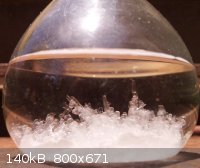
I gathered some of the solid and conducted the following tests:
1: some of the solid was put on the end of a metal spatula and heated over an alcohol burner. Although the substance did fizz a bit and give off a
smell of ammonia, the crystals were heated for long enough that they should of reached a temperature above 60 degrees (unless the decomposition is
endothermic).
2: Some HCl was added so a solution of the substance. This produced very vigorous bubbling, and the bubbles did not smell of ammonia so they could
well be CO2 formed by the neutralisation of the ammonium carbamate.
The conclusion that can be drawn from these tests is that the substance is ammonium carbamate.
It should be noted that my Zinc oxide did not dissolve in the reaction mixture. However I prepared mine a different way because I found the ZnOH
precipitate almost impossible to filter. I reacted zinc with sulfuric acid, then precipitated the solution with excess carbonate. This was then dried
in an oven, then heated in a crucible on a coke-fired forge for approximately 10-15 minutes, at temperature of around 100 degrees. The zinc oxide
formed was contaminated with a small amount of zinc carbonate still, because it bubbled upon the addition of HCl.
The patent also heated their zinc oxide to 500 degrees for 4 hours, so it looks like calcining is a good idea, if not necessary.
I'm afraid further experimentation will have to wait until I get a decent pump for my aspirator so I don't waster thousands of litres of water per
reaction.
[Edited on 27-11-2013 by Oscilllator]
|
|
|
deltaH
Dangerous source of unreferenced speculation
    
Posts: 1663
Registered: 30-9-2013
Location: South Africa
Member Is Offline
Mood: Heavily protonated
|
|
If ammonium carbamate is being produced, then this suggest that a polyether polymer is produced as well.
I believe the observation of a thickening of the reaction mixture into a plastic was mentioned early on in the thread, now we have some idea of why
and what.
It sounds like this reaction suffers from a serious side reaction problem that would hit carbonate selectivity and results in the formation of
ammonium carbamate which lowers yields 
|
|
|
UnintentionalChaos
International Hazard
    
Posts: 1454
Registered: 9-12-2006
Location: Mars
Member Is Offline
Mood: Nucleophilic
|
|
Quote: Originally posted by deltaH  | If ammonium carbamate is being produced, then this suggest that a polyether polymer is produced as well.
I believe the observation of a thickening of the reaction mixture into a plastic was mentioned early on in the thread, now we have some idea of why
and what.
It sounds like this reaction suffers from a serious side reaction problem that would hit carbonate selectivity and results in the formation of
ammonium carbamate which lowers yields 
|
What are you talking about... The "ammonium carbonate" formation is NOT stoichiometric and why do you insist that it's ammonium carbamate? Both
reactants are hygroscopic and unless rigorously dried likely contain some water. The water is "destroyed" by the reaction mixture through reaction
with urea and makes itself anhydrous. And where do you think polyether byproduct is coming from? Condensation of alcohols requires acidic catalysis,
whereas this is swamped with ammonia.
Department of Redundancy Department - Now with paperwork!
'In organic synthesis, we call decomposition products "crap", however this is not a IUPAC approved nomenclature.' -Nicodem
|
|
|
bfesser
Resident Wikipedian
    
Posts: 2114
Registered: 29-1-2008
Member Is Offline
Mood: No Mood
|
|
deltaH, you've already derailed one thread on this topic. Please try to keep this one within the realm of reality. Thank you.
|
|
|
Nicodem
Super Moderator
      
Posts: 4230
Registered: 28-12-2004
Member Is Offline
Mood: No Mood
|
|
Good work, Oscilllator. Keep us updated.
Quote: Originally posted by Oscilllator  | | This mixture was then distilled at atmospheric pressure. There were no distinct fractions, the temperature a the still head rose smoothly from 180 to
240 degrees. The boiling point of propylene glycol is 188 and the b.p. of propylene carbonate is 242. |
A normal distillation column should handle such a bp difference, even a double distillation trough a simple Vigreux column should do it. Try
redistilling it and try another column if you have it. Make sure you insulate it really good and preferably do it under vacuum (that is too high of a
temperature for atmospheric distillations, you loose too much heat by radiation and this can deteriorate the separation).
Attached is an OPRD review article of some relevance:
A Brief Review on Industrial Alternatives for the Manufacturing of Glycerol Carbonate, a Green Chemical
Ochoa-Gómez et al.
Org. Process Res. Dev., 2012, 16, 389–399. DOI: 10.1021/op200369v
Attachment: A Brief Review on Industrial Alternatives for the Manufacturing of Glycerol carbonate.pdf (666kB)
This file has been downloaded 819 times
…there is a human touch of the cultist “believer” in every theorist that he must struggle against as being
unworthy of the scientist. Some of the greatest men of science have publicly repudiated a theory which earlier they hotly defended. In this lies their
scientific temper, not in the scientific defense of the theory. - Weston La Barre (Ghost Dance, 1972)
Read the The ScienceMadness Guidelines!
|
|
|
deltaH
Dangerous source of unreferenced speculation
    
Posts: 1663
Registered: 30-9-2013
Location: South Africa
Member Is Offline
Mood: Heavily protonated
|
|
| Quote: | | What are you talking about... The "ammonium carbonate" formation is NOT stoichiometric and why do you insist that it's ammonium carbamate? Both
reactants are hygroscopic and unless rigorously dried likely contain some water. The water is "destroyed" by the reaction mixture through reaction
with urea and makes itself anhydrous. And where do you think polyether byproduct is coming from? Condensation of alcohols requires acidic catalysis,
whereas this is swamped with ammonia. |
UnintentionalChaos, you keep calling this stuff "ammonium carbonate", I and others are talking about ammonium
carbamate,NH4COONH2, it's not the same thing as carbonate. Ammonium carbamate forms from ammonia and CO2. Ammonium carbonate,
(NH4)2CO3, however, also requires water to form, it's equilibrium reaction is:
2NH3 + CO2 + H2O <=> (NH4)2CO3 + heat
Whereas carbamate's equilibrium is:
2NH3 + CO2 <=> NH4COONH2 + heat
As this reaction, for all intent and purpose, can be considered anhydrous, it is highly unlikely that these crystals are ammonium carbonate.
I have never claimed that ammonium carbamate forms in stoichiometric amounts, it appears to be a byproduct of this reaction and have stated it as
such. This means it lowers yields. Look at the picture Oscillator had posted above, there's lots of it there.
| Quote: | | And where do you think polyether byproduct is coming from? Condensation of alcohols requires acidic catalysis, whereas this is swamped with ammonia.
|
I trust that you know that alkyl carbonates are green alkylating agents. Dimethyl carbonate, for example, can be used as a methylating reagent with
release of CO2. See the following from wiki's article on the compound:
a b Shieh, Wen-Chung; Dell, Stephen; Repič, Oljan (2002). "Nucleophilic Catalysis with 1,8-Diazabicyclo[5.4.0]undec-7-ene (DBU) for the
Esterification of Carboxylic Acids with Dimethyl Carbonate". J. Org. Chem. 67 (7): 2188–2191. doi:10.1021/jo011036s.
Shieh, Wen-Chung; Dell, Steven; Repič, Oljan (2001). "1,8-Diazabicyclo[5.4.0]undec-7-ene (DBU) and Microwave-Accelerated Green Chemistry in
Methylation of Phenols, Indoles, and Benzimidazoles with Dimethyl Carbonate". Organic Letters 3 (26): 4279–81. doi:10.1021/ol016949n. PMID 11784197.
The alkylations result in the production of CO2 which is the overall driving force for it to proceed, however, it is slow, requires high temperatures.
Before it was discovered that DBU catalysed this reaction efficiently at dimethylcarbonate's b.p of 90C, one needed an autoclave to affect this at
much higher temperatures, however, with ethylene and propylene carbonates, you don't have this problem by virtue of the high b.p of both their glycols
and carbonate.
Thus I don't see why it's not surprising that ethylene or propylene carbonate that forms, cannot to some degree also 'alkylate' unreacted glycols
forming an ether and eliminating CO2 as this is what alkyl carbonates are known to do, particularly at such high temperatures.
So that would mean you have both NH3 and CO2 coming of from the reaction mixture and so these simply condense to ammonium carbamate in the cooler
parts of the apparatus.
There is probably good reason why ethylene and propylene carbamates are industrially manufactured their respective epoxides and CO2. Epoxides cannot
be alkylated!
I am not saying this reaction cannot produce ethylene or propylene carbonate, I am saying it may suffer from reduced selectivity because of the side
reaction of forming both ammonium carbamate and polyethers in the reaction mixture.
[Edited on 27-11-2013 by deltaH]
|
|
|
Nicodem
Super Moderator
      
Posts: 4230
Registered: 28-12-2004
Member Is Offline
Mood: No Mood
|
|
Quote: Originally posted by deltaH  | | UnintentionalChaos, you keep calling this stuff "ammonium carbonate", I and others are talking about ammonium
carbamate,NH4COONH2, it's not the same thing as carbonate. |
Yes it is. What is commonly called "ammonium carbonate" is not ammonium carbonate, but a mixture of ammonium carbamate and bicarbonate:
https://www.sciencemadness.org/whisper/viewthread.php?tid=20...
Anhydrous ammonium carbamate actually exist at room temperature, but at the temperatures of this reaction, it reversibly reverts to urea, "ammonium
carbonate", ammonia, water and carbon dioxide (DOI: 10.1021/ie50286a008). So it is improper to identify the sublimate as ammonium carbamate, unless
you have evidence. It would be more reasonable to talk about "ammonium carbonate" or "sublimed urea" or whatever else undefined, as at least that
would be closer to reality than claiming it to be a discrete compound without any evidence.
…there is a human touch of the cultist “believer” in every theorist that he must struggle against as being
unworthy of the scientist. Some of the greatest men of science have publicly repudiated a theory which earlier they hotly defended. In this lies their
scientific temper, not in the scientific defense of the theory. - Weston La Barre (Ghost Dance, 1972)
Read the The ScienceMadness Guidelines!
|
|
|
bfesser
Resident Wikipedian
    
Posts: 2114
Registered: 29-1-2008
Member Is Offline
Mood: No Mood
|
|
Quote: Originally posted by deltaH  | Shieh, Wen-Chung; Dell, Stephen; Repič, Oljan (2002). "Nucleophilic Catalysis with 1,8-Diazabicyclo[5.4.0]undec-7-ene (DBU) for the
Esterification of Carboxylic Acids with Dimethyl Carbonate". J. Org. Chem. 67 (7): 2188–2191. doi:10.1021/jo011036s.
Shieh, Wen-Chung; Dell, Steven; Repič, Oljan (2001). "1,8-Diazabicyclo[5.4.0]undec-7-ene (DBU) and Microwave-Accelerated Green Chemistry in
Methylation of Phenols, Indoles, and Benzimidazoles with Dimethyl Carbonate". Organic Letters 3 (26): 4279–81. doi:10.1021/ol016949n. PMID 11784197.
|
<strong>deltaH</strong>, stop throwing around citations like this as if they actually have
meaning—let alone support your argument. Without providing us with access the actual papers, these are meaningless (to the vast majority of
us). Your habitual tactics of obfuscating your argument and <em>'if you can't explicitly prove me wrong, it must be true'</em> are really
getting on my nerves. Since it's impossible to empirically disprove something (this philosophical topic is not open for discussion in this thread),
you may find your posts in Beginnings or Detritus, if you continue in this fashion. Finally, for Farraday's sake,
at least format out the Wikipedia junk from your copy-pasta.
[edit] Nicodem; likewise, please share references.
[Edited on 27.11.13 by bfesser]
|
|
|
deltaH
Dangerous source of unreferenced speculation
    
Posts: 1663
Registered: 30-9-2013
Location: South Africa
Member Is Offline
Mood: Heavily protonated
|
|
Quote: Originally posted by Nicodem  | Quote: Originally posted by deltaH  | | UnintentionalChaos, you keep calling this stuff "ammonium carbonate", I and others are talking about ammonium
carbamate,NH4COONH2, it's not the same thing as carbonate. |
Yes it is. What is commonly called "ammonium carbonate" is not ammonium carbonate, but a mixture of ammonium carbamate and bicarbonate:
https://www.sciencemadness.org/whisper/viewthread.php?tid=20...
Anhydrous ammonium carbamate actually exist at room temperature, but at the temperatures of this reaction, it reversibly reverts to urea, "ammonium
carbonate", ammonia, water and carbon dioxide (DOI: 10.1021/ie50286a008). So it is improper to identify the sublimate as ammonium carbamate, unless
you have evidence. It would be more reasonable to talk about "ammonium carbonate" or "sublimed urea" or whatever else undefined, as at least that
would be closer to reality than claiming it to be a discrete compound without any evidence. |
You make good points, so I am happy with calling it "ammonium carbonates" then in the absence of more specific characterisation. My main thought here
was that only ammonium carbamate can form in the absence of water as both bicarbonate and carbonate ion formation require water in their
stoichiometric equations.
UnintentionalChaos, I concede that small amounts of water may be present in not completely dry reagents. However, if this is
responsible for forming the "ammonium carbonate" by product, then it may be suppressed by employing dry reagents.
Perhaps Oscillator could comment on the issue of moisture here.
This "ammonium carbonates" is bound to be a nuisance in the product as I suspect significant amounts would be soluble in the ethylene/propylene
carbonate product collected.
Perhaps after filtering/decanting the majority of the alkyl carbonates from the crystalline mass, one can pull a vacuum for extended periods of time
to remove the majority remaining in solution. "Ammonium carbonates" do have appreciable vapour pressure at RT while the carbonates vapour pressures
are extremely small.
[Edited on 27-11-2013 by deltaH]
|
|
|
UnintentionalChaos
International Hazard
    
Posts: 1454
Registered: 9-12-2006
Location: Mars
Member Is Offline
Mood: Nucleophilic
|
|
Quote: Originally posted by deltaH  |
You make good points, so I am happy with calling it "ammonium carbonates" then in the absence of more specific characterisation. My main thought here
was that only ammonium carbamate can form in the absence of water as both bicarbonate and carbonate ion formation require water in their
stoichiometric equations.
|
While you may be able to form ammonium carbamate in the absence of water from ammonia and carbon dioxide, I think you'll find it quite impossible to
make it from urea in the absence of water.
OCN2H4 + H2O --> NH4CO2NH2
Department of Redundancy Department - Now with paperwork!
'In organic synthesis, we call decomposition products "crap", however this is not a IUPAC approved nomenclature.' -Nicodem
|
|
|
deltaH
Dangerous source of unreferenced speculation
    
Posts: 1663
Registered: 30-9-2013
Location: South Africa
Member Is Offline
Mood: Heavily protonated
|
|
Quote: Originally posted by UnintentionalChaos  | Quote: Originally posted by deltaH  |
You make good points, so I am happy with calling it "ammonium carbonates" then in the absence of more specific characterisation. My main thought here
was that only ammonium carbamate can form in the absence of water as both bicarbonate and carbonate ion formation require water in their
stoichiometric equations.
|
While you may be able to form ammonium carbamate in the absence of water from ammonia and carbon dioxide, I think you'll find it quite impossible to
make it from urea in the absence of water.
OCN2H4 + H2O --> NH4CO2NH2 |
I believe that Oscillator's observations:
| Quote: | I gathered some of the solid and conducted the following tests:
1: some of the solid was put on the end of a metal spatula and heated over an alcohol burner. Although the substance did fizz a bit and give off a
smell of ammonia, the crystals were heated for long enough that they should of reached a temperature above 60 degrees (unless the decomposition is
endothermic).
2: Some HCl was added so a solution of the substance. This produced very vigorous bubbling, and the bubbles did not smell of ammonia so they could
well be CO2 formed by the neutralisation of the ammonium carbamate. |
Makes it very hard to believe that this crystalline material is anything other than an "ammonium carbonate". Can you suggest an alternative that fits
the experimental observations better?
As I have explained, I believe that CO2 is generated by alkyl carbonate alkylating free alcohol groups as this is known behaviour of alkyl carbonates
at high temperature. Thus you have the two ingredients required for carbamate formation, NH3 and CO2. You simply need to condense them in cooler
parts.
[Edited on 28-11-2013 by deltaH]
|
|
|
Oscilllator
National Hazard
   
Posts: 659
Registered: 8-10-2012
Location: The aqueous layer
Member Is Offline
Mood: No Mood
|
|
One more observation I have made:
I tried to force more of the compound to crystallise out of solution by placing it in the freezer (as opposed to an ambient temp of 20+ degrees).
Instead of more of the substance crystallising out it appears that the compound partially redissolved. this supports the notion that the substance is
ammonium carbonate (NH3)2CO3, since its has a solubility of 55g/100ml at 0 degrees as opposed to 10g/100ml at 20 degrees.
Source: http://en.wikipedia.org/wiki/Solubility_table
|
|
|
Metacelsus
International Hazard
    
Posts: 2531
Registered: 26-12-2012
Location: Boston, MA
Member Is Offline
Mood: Double, double, toil and trouble
|
|
My Attempt
Tonight I am attempting the synthesis of propylene carbonate:
A mechanical stir bar, 73.4 ml (1 mol) of food-grade propylene glycol, 40 g (2/3 mol) of cold pack urea, and 1.5 g ZnO catalyst (made from
Zn->ZnCl2->Zn(OH)2->ZnO) were placed in a 500 ml Erlenmeyer with 24/40 joint, and a Liebig condenser was attached to
the top (for reflux). The flask was heated to reflux, and the ammonia gas produced was dissolved in HCl. A white solid was noted in the reflux
condenser above the condensation line.
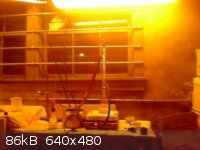 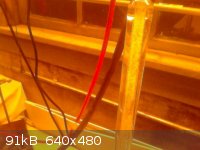 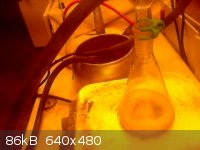 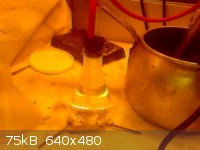
The white solid ended up clogging the condenser, so I had to stop the reaction before it was done. Tomorrow I will try to figure out what the solid
is. It has a nasty smell, similar to ammonia but not quite the same.
12/18
I tested the white solid with HCl and NaOH. With HCl it gave CO2, and with NaOH it gave NH3. Thus, it is most likely an ammonium
carbonate or carbamate of some sort. I tested the reaction mixture, which had turned brown, for biuret, and it gave only a weak color change. I then
tested my urea starting material, and it gave the same result, so I think any biuret impurities may have come from there.
https://en.wikipedia.org/wiki/Biuret_test
I resumed the reaction as before. This time, no solids clogged the condenser. When the reaction is done, I will distill the mixture under vacuum to
(hopefully) get my product.
[Edited on 18-12-2013 by Cheddite Cheese]
|
|
|
Metacelsus
International Hazard
    
Posts: 2531
Registered: 26-12-2012
Location: Boston, MA
Member Is Offline
Mood: Double, double, toil and trouble
|
|
I completed the reaction yesterday afternoon. I have just distilled off the unreacted propylene glycol at 27 in Hg (aspirator) vacuum. The volume of
the fraction was 25 ml. I still have about 30 ml of dark brown liquid which I assume is mostly propylene carbonate. I will distill that using my
rotary vane pump in the next few hours.
Update:
The distillation yielded only 8 ml of propylene carbonate: the rest was polymerized gunk that carbonized on the bottom of the flask when the propylene
carbonate was distilled off. If I try the reaction again, I will do it under vacuum to avoid this.
[Edited on 20-12-2013 by Cheddite Cheese]
|
|
|
Oscilllator
National Hazard
   
Posts: 659
Registered: 8-10-2012
Location: The aqueous layer
Member Is Offline
Mood: No Mood
|
|
Cheddite nice work! Its good to see other people interested enough to actually go and and experiment  . How did you determine that it was propylene carbonate? Boiling point? Do you think that the propylene carbonate
formed would be adequately pure for making alkali metals, or would it need additional purification, perhaps by one or more further distillations.
Forgive me for not posting links, as I'm on holiday in Indonesia so I'm using my mobile. . How did you determine that it was propylene carbonate? Boiling point? Do you think that the propylene carbonate
formed would be adequately pure for making alkali metals, or would it need additional purification, perhaps by one or more further distillations.
Forgive me for not posting links, as I'm on holiday in Indonesia so I'm using my mobile.
|
|
|
Metacelsus
International Hazard
    
Posts: 2531
Registered: 26-12-2012
Location: Boston, MA
Member Is Offline
Mood: Double, double, toil and trouble
|
|
I determined it by boiling point and density. It probably needs an additional distillation, but I only have a tiny bit and no small-scale distillation
glassware. I'm going to try making some more propylene carbonate in the next few days, probably on a larger scale and reacting under vacuum. It's nice
that propylene glycol and urea are relatively cheap.
Also, I have weighed my ammonium chloride from the scrubber (I evaporated the liquid). I have 62 grams, which is only 9 g below the theoretical 4/3
mol. This indicates that the reaction probably went to completion.
|
|
|
Dr.Bob
International Hazard
    
Posts: 2660
Registered: 26-1-2011
Location: USA - NC
Member Is Offline
Mood: No Mood
|
|
That is pretty good. From the little bit I was able to find on this reaction, few people have made it from OTC chemicals in great yields or purity,
there are many papers that make it in low yield and low purity, especially the Russians. I did a quick literature search, just out of curiosity,
and here is a PDF of about 100 routes and literature refs for those who might be interested in trying other methods. Some look rather interesting,
some look horrible. I can try to find the articles for any that look very promising to people. Be aware that they don't always list all of the
chemicals used, so some that look easy are not actually that simple. I was thinking of just using propylene glycol and carbonyl imidazole, not sure
if that would work well or just polymerize, likely needs to be dilute.
Attachment: propylene carbonate preps.pdf (192kB)
This file has been downloaded 1170 times
One example (5b) from the list:
"Mitsubishi Gas Chemical Company, Inc.
Patent: US5349077 A1, 1994 ;
2:EXAMPLE 12
A 500-ml three-necked flask, equipped with a stirrer, reflux condenser and thermometer, was charged with 60.1 g (1.00 mole) of urea, 190.3 g (2.50
mole) of 1,2-propylene glycol and 1.5 g of zinc oxide. The reaction was carried out at 145° C. for 2 hours at the pressure of 165 mmHg with stirring
and refluxing of the ammonia produced. The reaction vessel was cooled after the reaction was stopped and 218.4 g of reaction solution was obtained.
Gas-chromatography analysis showed that the amount of unreacted 1,2-propylene glycol was 116.1 g and the amount of produced 1,2-propylene carbonate
was 99.2 g. "
------------------
Another is J. Org. Chem. 2000, 65, 6368-6380:
http://pubs.acs.org/doi/abs/10.1021/jo000257f
which is the last one, making PC from 1,2-propylene glycol, Boc anhydride, and DMAP in good yield.
[Edited on 20-12-2013 by Dr.Bob]
|
|
|
|